Commodus, Roman Emperor and Gladiator
“Who was the worst Roman emperor?” is a commonly asked question, and one which is difficult to answer for many reasons. Not least of those is “worst for whom?” Rome was a slave economy after all, so an emperor good for the city of Rome was likely bad for the people who were conquered and enslaved. Taken as “who was worst for Rome”, though, the answer becomes simpler. Though there were emperors whose reigns had worse consequences for the city, in general those emperors inherited bad situations and made them worse. But no other emperor quite managed to take a Rome at the height of its powers and solely through their mismanagement destroy it quite like Commodus.
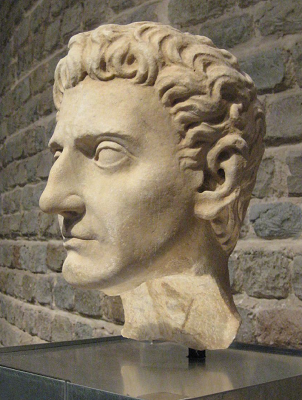
The Rome that Commodus inherited came at the end of the reign of the “Five Good Emperors”. The first of these was Marcus Cocceius Nerva, a longtime civil servant and imperial advisor. Nerva was voted as emperor by the Roman Senate after the assassination of Domitian, and though his reign was short he did much to stabilise the Roman economy. He was also smart enough to know when his reign started to slip, so he appointed Trajan (a popular general) as his successor. Trajan was succeeded by Hadrian, who Trajan’s widow claimed had been adopted by Trajan on his deathbed. This might even have been true.
Hadrian is an example of an emperor who was good for Rome and bad for other people. For example, Jewish records of him generally follow his name with “may his bones be crushed”. Nowadays he is most remembered for building a wall marking the northern boundary of Roman Britain but he was also responsible for many other public works. He was succeeded by Antoninus Pius, who adopted two sons: Lucius Verus and Marcus Aurelius. When he died they succeeded him as co-Emperors, until eight years into their reign when Lucius died of an uncertain disease. Marcus Aurelius ruled on alone, and became the first of these emperors to have a biological son to succeed him. Which is, of course, where things went wrong.
Lucius Aurelius Commodus and his twin brother Titus Aurelius Fulvus Antoninus were born on the 31st of August in the Roman year 914, nowadays better known as 161 AD. [1] This was only a few months after the the death of Antoninus Pius. His mother Faustina was actually the youngest daughter of Antoninus, and though later histories slandered her as an adultress in truth she and Marcus Aurelius seem to have made a solid match. The had thirteen children, with Titus and Commodus as the tenth and eleventh respectively. But in a sad reflection of child mortality at the time, though Commodus was their seventh son he was the only one who would survive to adulthood.
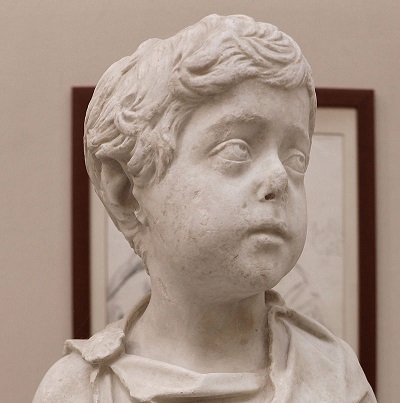
Titus died when he and Commodus were four years old, and the following year Commodus was officially given the rank of “Caesar”. Originally Augustus had taken Julius Caesar’s cognomen to emphasize his connection to the great man, but it had become the traditional marker that someone was to be considered a member of the Imperial family and so was in line for the succession. Commodus’ younger brother Marcus Annius Verus was also made a Caesar, though he died in 169 AD at the age of seven after an attempt was made to remove a tumour from behind his ear. This left Commodus as sole heir to Marcus Aurelius, who became sole Emperor the same year.
Notoriously, Marcus mourned his dead son for a mere five days. His justification was that the holy games of Jupiter were going on, and it was his sacred duty as Emperor to officiate. In truth, it was very much in character for him to shun a public display of grief. Marcus Aurelius had a reputation as a “philosopher king”, and his philosophy was Stoicism. In fact a lot of our knowledge of this school of philosophy comes from his writings. Self-control and freedom from passion were key to the Stoic way of life. This was the strict worldview that Commodus was raised in.
By 172 AD the eleven year old Commodus was accompanying his father on campaign, along with his mother Faustina. At the time Marcus was leading forces in the north against the German tribes, who always caused trouble on the border. It was in recognition of them being driven back that Commodus was given the title of “Germanicus”, with which Marcus somewhat farcically credited the child with being the reason for the Roman victory. This was part of him attempting to legitimise Commodus as an heir, since for a long time genuine dynastic succession like this had not been a part of the Roman system.
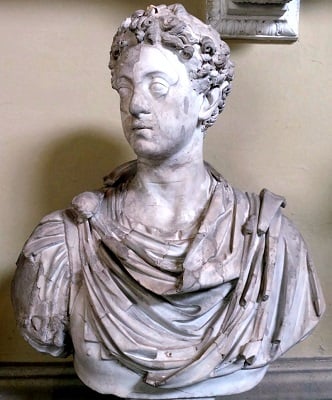
175 AD saw Commodus undergo the Roman rites of manhood and gain the privilege of wearing the garb of a Roman citizen, a toga. He underwent these ceremonies while his father was mobilising the army to put down a revolt in Egypt. Marcus had fallen ill and rumours had spread of his death, leading the governor of Egypt, Avidius Cassius, to rebel. Egypt was a vitally important province as it produced the grain that fed the city of Rome. Marcus thus wasted no time in mobilising to put down this revolt, though as it turned out he needn’t have bothered. Once it became clear he was alive and the revolt had no chance of success Cassius was murdered by his own men, who sent his head to Rome as proof that the revolt was over.
Faustina died in the winter of 175, in a town called Halala in modern day Turkey. Unlike when his son had died, Marcus did grieve deeply for his wife’s death. He renamed Halala as Faustinopolis, and had her deified by the Senate. In the aftermath of her death Marcus took Commodus on a tour of the eastern provinces, which culminated into a visit to Greece where they took part in the secret rites of Demeter known as the Eleusinian Mysteries. (This had become a status symbol for the Greek-obsessed Romans.) Then they returned to Rome.
Over the next few years Marcus did his best to consolidate Commodus as his heir. This included making him a consul in 177, aged only fifteen. At the time he was the youngest person to hold what had been (in the days of the Roman Republic) the supreme position of power of Rome. Now it was simply a tool the Emperor used to show his favour. Following this consulship Marcus made his son co-Emperor. Commodus was also married off to Bruttia Crispina, a fourteen year old heiress of a rich aristocratic Roman family. The two Emperors then set off to the northern front, as the victory celebrations against the Germans had been slightly premature.
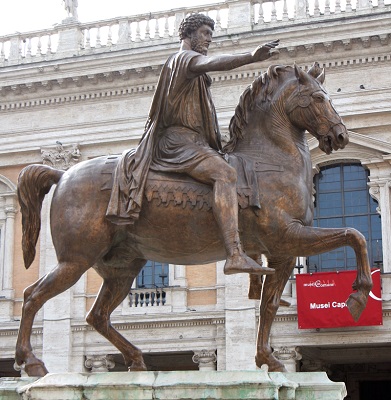
By now Marcus Aurelius was fifty-eight years old, an advanced age back in those times. As the army traveled through Vindobona (modern Vienna) he fell ill, and he feared (correctly) that this could be the end for him. Herodian of Antioch [2] later wrote that Marcus was nervous, thinking about previous rulers who had gained the throne at a young age and been corrupted by it. He was also afraid that the enemies of Rome would see this as an opportunity to act. So he summoned all of his friends and kinsmen, told them to remember all that he had done for them and asked them in memory of him to act as fathers to his son after he was gone. The next day he died, and Commodus became emperor. It was only the third time in Roman history that a ruler had been succeeded by his biological son, at least since the days of the last king Tarquin the Proud (link!) six hundred years before, and the first time one had been “born to the purple” as the Emperor’s son.
Commodus began his reign by ending the campaign against the Germanic barbarians. This was against strenuous protests from his father’s advisors and generals, who saw it as a betrayal of the twelve years they had spent trying to conquer Germany. On the other hand, the soldiers saw it as a chance to escape from the hellish forests along the Danube, where hordes of barbarians would suddenly ambush them and melt away. They were delighted when (after leading one last sortie against a weak enemy force so he could declare “victory”) Commodus packed them all up and headed back to the comforts of Rome.
Once they had returned to the Eternal City, Commodus began throwing himself into all the pleasures of the flesh that had been denied by his Stoic father. He was uninterested in the details of running the Empire, so that fell to the advisors his father had left him, the Senate, and the Imperial Chamberlain. This last was a Greek man named Saoterus, a former slave who had been a friend of Commodus for years. Some sources insinuate that the two men were lovers, but whether that was true or not he was someone who Commodus trusted enough to run his empire for him.
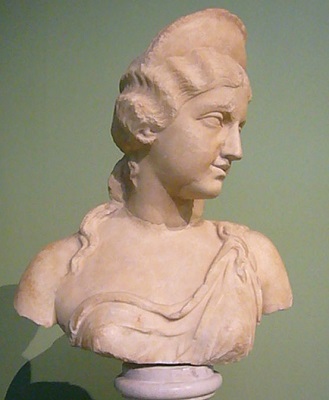
Marcus Aurelius had done a good job of clearing out any potential rivals to his son, with the result that Commodus got away with his laissez-faire approach for the first two years of his reign. In fact the first trouble came not from his rival, but from his wife Crispina’s. Lucilla, the elder sister of Commodus, had been the wife of Marcus’ co-emperor Lucius Verus. This had given her the rank of Augusta (or “Empress”), and after Faustina’s death she had been the First Lady of the Empire. Until Commodus became emperor, and his wife became the Augusta.
Lucilla had remarried to a senior senator named Tiberius Claudius Pompeianus, and she began conspiring with a group including the prefect of the Praetorian Guard to have her husband made emperor once Commodus had been removed. (The Praetorian Guard were officially the Emperor’s bodyguard, but in truth they were usually the ones involved in plotting against him.) Part of the plot involved framing Saoterus for the assassination, while they recruited one of Lucilla’s lovers, Quintianus, to do the actual killing. Pompeianus, Lucilla’s husband, was left out of the plot partially to give him clean hands and partially in case he had cold feet.
Of course, the entire plot hinged on Quintianus killing Commodus. He ambushed him from a doorway as the Emperor was returning from the theatre, but he bungled the job. Some sources say that he grandstanded before attacking Commodus and declared “This is a gift from the Senate!” If true, that was a statement that would have serious consequences. However it happened, he was overpowered by the Emperor’s bodyguards, and captured alive. It was a catastrophic failure.
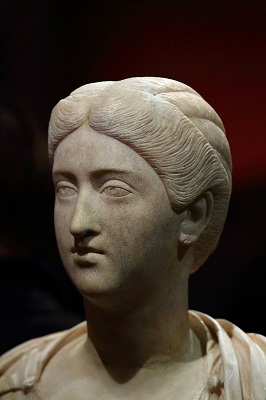
Quintianus was tortured and gave up all the conspirators he knew of, including Lucilla. Most of them were executed. Lucilla, as a noblewoman, was simply forced into exile. (As was traditional, Commodus had her secretly murdered a few years later. Ironically poor Crispina, his wife, would suffer the same fate six years later. Her crime, laid by her constantly unfaithful husband, was “adultery”.) Quintianus didn’t know about the Praetorian involvement, but the prefect (Tarrutenius Paternus) had already murdered Saoterus “resisting arrest” for his part in the conspiracy. Commodus was enraged and had Paternus arrested and executed. He was replaced by his second in command, Tigidius Perennis, who managed to cover up his own involvement in the conspiracy. In fact Perennis ingratiated himself with Commodus enough to take over Saoterus’ position as right hand man to the emperor.
Though Perennis was now Commodus’ trusted steward, he had enough other duties that he did not act as chamberlain for the imperial household. That job went to Marcus Aurelius Cleander, a freedman like Saetorus had been. (”Freedmen”, former slaves, were forbidden from pubic office and so naturally gravitated in to civil service.) Cleander soon gained Commodus’ trust by agreeing to “marry” one of the emperor’s mistresses, though of course this was solely for the sake of appearances. Commodus had no idea that Cleander was one of those who had carried out the murder of his friend Saoterus.
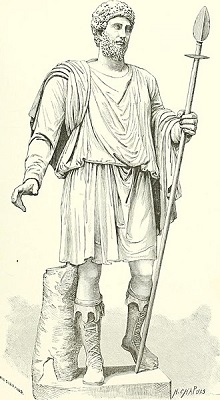
The attempt on his life broke Commodus out of his complacency and left him in a dangerously paranoid state. Dangerous, that is, for those around him. Perennis took advantage of this paranoia to direct Commodus in a purge of the senate, a purge that just happened to sweep up both political enemies of Perennis and rich men whose property he was able to confiscate. Commodus was mollified by this, enough that he didn’t notice how Perennis was buttering up the army with gifts and maneuvering his sons into command positions.
The ancient histories are divided on whether Perennis was plotting to overthrow Commodus and Cleander took advantage of it, or if Cleander framed the prefect. The first rumbling came several years after the Lucilla incident, when someone invaded the stage and denounced Perennis. The prefect managed to convince the emperor that this was a lie, and the man was executed. However the following year when some soldiers were reassigned from Britain to Italy they asked for permission to see the emperor. They had been under the command of Perennis’ son in Britain, and they had coins allegedly minted there showing Perennis as emperor. Based on that evidence Commodus ordered Perennis and his entire family executed. This left Cleander effectively in control of the empire.
That was bad news for the empire. Perennis might have been corrupt and scheming, but he had a career of command and was a competent administrator. Cleander was not. He ran the empire as a bandit king, seeking only to extract the maximum amount of profit he could out of it. Public offices had always informally been sold off, but Cleander raised it to an art form. Senatorial positions, governorships, army commands, all could be had for a price. Even the consulship, once the highest rank in Roman society, could be bought. In 190 AD, ten years into the reign of Commodus, there were 25 consuls all of whom had paid for the privilege. In the meantime the infrastructure of the empire was beginning to crumble, and cracks were starting to appear.
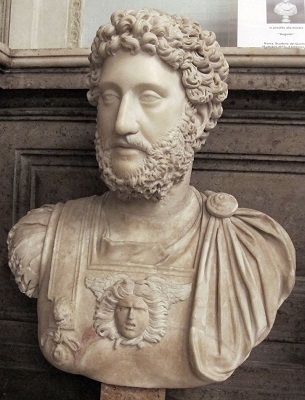
What was Commodus doing while his empire was falling apart? Playing at being a gladiator, of course. All of Rome was fascinated by the gladiatorial games, where men risked their lives for the screaming crowds. The fact that Commodus loved the games (and generously financed them) was part of why he was so popular among the people of Rome. But thought they loved the games, the Romans in general had little but contempt for the actual gladiators themselves. Perhaps they wouldn’t have been unable to stand the slaughter otherwise. Regardless, it became a national scandal when Commodus decided he didn’t just want to watch the games. He wanted to take part.
Now Commodus did train hard for his role as a gladiator. He had loved sports since he was a child, and he pushed himself into excellent physical shape. However there’s no getting around that he never did really put his life at risk. His opponents were usually weakened and given weapons made of soft lead, no match for the emperor’s steel. They also knew that if they wounded him they would almost certainly be killed, while if they put up a good show but were defeated then the “gracious” emperor would probably spare them. It’s not surprising then that Commodus soon began to think of himself as the greatest gladiator of all time. In the meantime the aristocrats of Rome began spreading rumours that Commodus was not the son of Marcus Aurelius, but that his mother Faustina had conceived him during an affair with a gladiator.
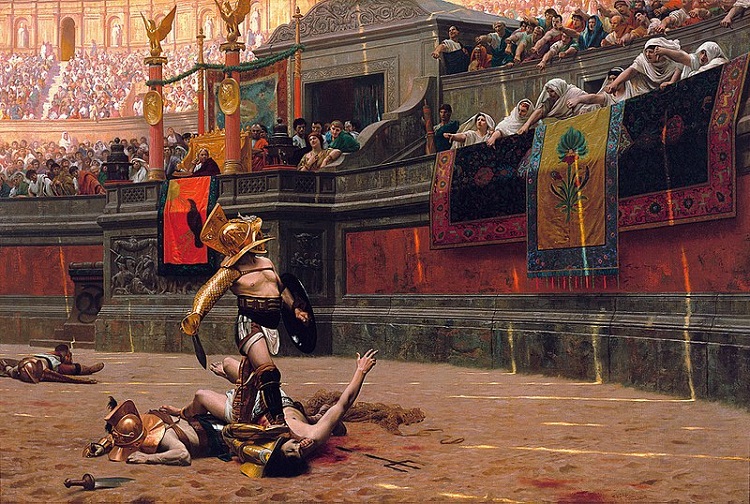
Not all of his opponents in the arena were gladiators, or even human. Commodus began to think of himself as one of the great mythic heroes, and so he decided that he should fight “monsters”. Sometimes these were exotic animals like giraffes, but all too often they were people who had some “amusing” disability. Dwarfs and people missing limbs (from accident or birth) were a particular favourite. They would be captured on the street or bought as slaves, and then sent into the arena so that Commodus could kill them for sport. This was one of the things that hurt the emperor’s popularity, not because the public found it barbaric but because they found it boring. Sometimes Commodus would also show off his archery skills, and on one notable occasion he decapitated an emu with a single arrow.
Despite all of this Commodus remained very popular with the people of Rome, which is why when there was a food shortage in 190 AD they didn’t blame him for it. They blamed Cleander. This was exactly what the prefect in charge of the grain supply, Papirius Dionysius, had hoped for. He had been prefect of Egypt until the previous year, when Cleander had displaced him in favour of someone who had paid more. When the grain supplies were interrupted, Dionysius should have used the reserves to prevent the people of Rome from starving. He didn’t, they did, and they rioted.
Commodus probably wouldn’t have paid that much attention to the civil unrest in Rome, except that the rioters found the one place that he wouldn’t ignore them – the arena of the Circus Maximus. A protest during a horse race led Commodus to dispatch the Praetorian Guard to pacify the streets. The prefect of Rome, a well-respected general named Pertinax, decided that this was an illegal use of the guard and sent the Vigiles Urbani (the City Watch, a combination of firemen and police) to prevent them from interfering with the rioters. Eventually Commodus decided that it would make his life easier to give them what they wanted. He handed over Cleander, who was promptly murdered. After things had calmed down, Commodus discovered that it was Papirius Dionysius who had fanned the flames and had him executed.

Tiring of the failures of his henchmen, Commodus now decided to take a more active role in governing the city. He was sure that he could do a good job of it, because he had now decided that he was a god. Specifically he had decided that he was the god Hercules reborn. In order to showcase this he had statues made showing him with the hero’s iconic lion skin and club – the same club he used to beat cripples and other unfortunates to death in the arena. The statues included the great Colossus of Nero next to the Colosseum, a 30-foot statue of Nero that later emperors had already transformed into the sun god Sol Invictus. Commodus beheaded the unconquered sun and replaced it with his own visage.
Commodus didn’t stop at declaring himself a god, though. By now between his imperial names and self-bestowed titles his full name was Lucius Aelius Aurelius Commodus Augustus Herculeus Romanus Exsuperatorius Amazonius Invictus Felix Pius. That made twelve names, the same as the number of months in the year. This wasn’t a coincidence, as Commodus officially renamed the months after each of his names. He went even further, though. After Rome was ravaged by a fire in 191 AD and needed extensive rebuilding, he decided it was no longer Rome. Rome was now “Colonia Lucia Annia Commodiana”, and its people were now “Commodianus”.
Unsurprisingly this was the point at which Commodus’ popular support began to fade. This was only partially due to the megalomania. It was also due to the economic mismanagement which meant that paying for the much-needed rebuilding work was difficult. Telling Commodus about any of these problems was an easy way to wind up dead, of course. It’s not surprising that plots against soon began, very discreetly, to spring up.
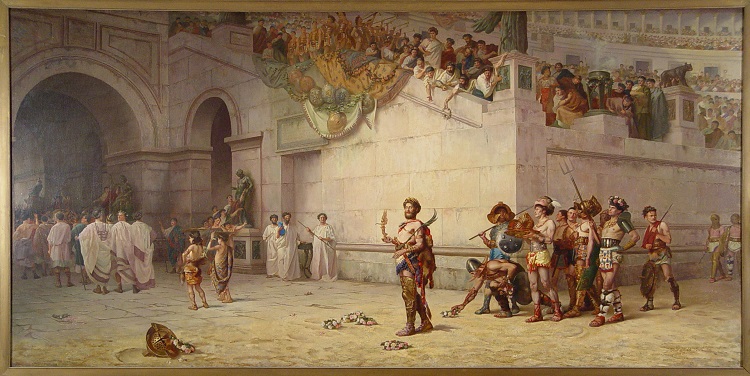
Legend has it that the trigger for the final plot against him was his plan for the New Year’s Day celebration at the end of 192 AD. This was one of the most sacred occasions in the Roman calendar, and his plan was to commemorate it with a procession of gladiators from the Colosseum to the Imperial Palace. He himself would take part in this procession as a gladiator. Commodus told his mistress Marcia about this plan and she was unable to stop herself from crying out against it. Later that day she walked into a scribe carrying messages, and while she was helping him gather them up she noticed her own name on a list of those scheduled for execution. She realised that if she didn’t do something, then she was doomed.
That’s one story of events, at least. Another more likely version is that the Praetorian prefect Quintus Aemilius Laetus and the chamberlain Eclectus formed a conspiracy to eliminate Commodus before they went the way of Perennis and Cleander. They recruited Marcia because of her access to the emperor and made a quiet agreement with the prefect Pertinax, a man well-respected by the Senate, people and army. When the throne was vacant Pertinax would step in with clean hands, and in return he would make sure that no reprisal for the death of Commodus fell on them.
The conspirators struck on New Year’s Eve, the last day of 192 AD. Originally Marcia tried to poison the emperor, but poisoning back then was often a hit and miss affair. Most versions of the story have Commodus feeling ill and forcing himself to vomit, though it’s uncertain whether he knew he was poisoned. Either way he retreated to his bath to try to sober up. Subtlety having failed, the conspirators went to their backup plan. They sent in one of the few people allowed to access the emperor’s bathroom, his personal trainer Narcissus. Narcissus then strangled the emperor to death. The earthly reincarnation of the god Hercules was no more, murdered at 31 years old.
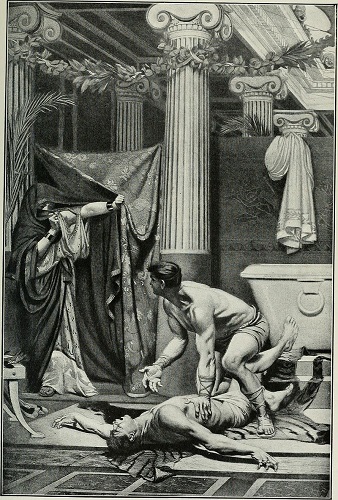
Nowadays Commodus is best remembered as the villain of Ridley Scott’s movie “Gladiator”, a sneering and arrogant portrayal by Joaquin Phoenix. The movie is far from historically accurate. Its protagonist, Maximus, is entirely fictitious. Its version of Lucilla might as well be. It has Marcus Aurelius murdered by Commodus for planning to return Rome to being a Republic; something that would have been wildly out of character for the stoic authoritarian. It drastically alters the death of Commodus, of course. But the single biggest lie in the movie is when it implies that the death of Commodus led to a happy ending for Rome. The truth was far from that.
At first, events after the emperor’s death went exactly according to plan. The senate acclaimed Pertinax as emperor, damned the memory of Commodus, and undid all his ambitious renaming. Unfortunately Pertinax miscalculated when he tried to reign in the Praetorian Guard. Having had their prefects effectively running the country several times in the last ten years they had grown use to lax discipline and hefty bribes. When Pertinax failed to come up with enough to satisfy him they murdered him on the steps of the imperial palace.
With Pertinax dead, there was no longer a “natural successor” to Commodus. The Praetorians decided to auction off the throne, and it was bought by a senator named Didius Julianus. Meanwhile three governors in different parts of the empire went into rebellion. This was why 193 AD became known as the Year of the Five Emperors, and it would be years of civil war before one of those governors prevailed and became undisputed emperor.

History has not been kind to Commodus. To be fair, he probably doesn’t deserve kindness. But he also probably doesn’t deserve to be given sole credit for destroying the Roman Empire, as some historians claim. The long-term worst decision he made was probably to abandon the northern campaign, as that left barbarians who would ravage and eventually destroy the Western Empire. But conquering them would merely have exacerbated the other problem that destroyed Rome: that the Empire simply grew too large to live. Controlling it required powerful independent governors, exactly like those who rebelled after the death of Pertinax. But the real reason Commodus should not get that blame for “destroying” Rome is that it would not be until 400 years after his death that the Western Empire finally fell. There are a lot of modern countries that have not been around for half that amount of time. Empires are resilient things, and it takes more than one bad ruler to kill them off; even one so undeniably bad as Commodus.
Images via wikimedia except where stated.
[1] The “AD” system of years didn’t become common until about six hundred years later, and wasn’t universally adopted in Europe until the 15th century.
[2] Herodian was writing about fifty years later, and his accuracy has been hotly debated over the years. Though he did live through the times he wrote about, like most contemporary writers he did have his own politics that he brought to the table. He’s still one of our best sources for a crucial period in Roman history, of course.
